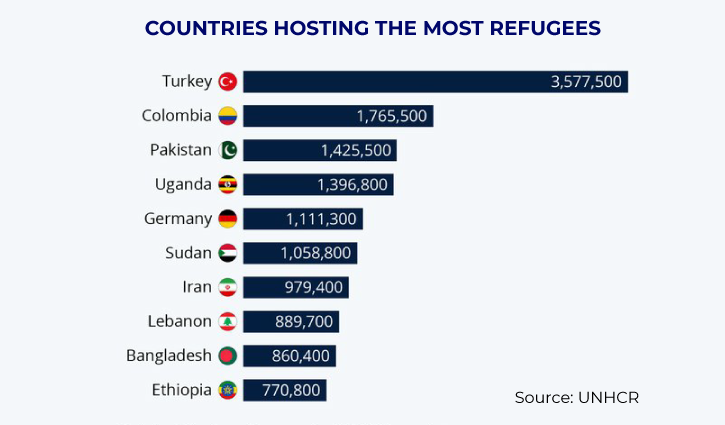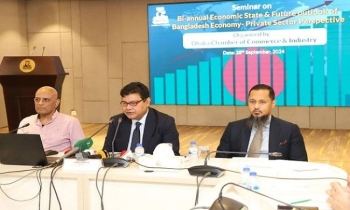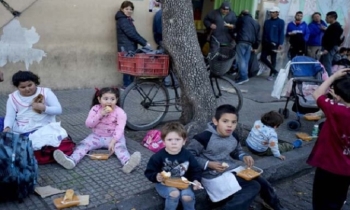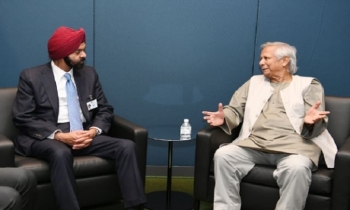Russia-Ukraine conflict further debunks refugee movement myth
BI Report || BusinessInsider

Graphics: Business Insider Bangladesh
It is often touted in conservative western media that refugees fleeing from their homeland are economic migrants who choose rich European countries as their destination. They also point out that these “so-called” refugees walk to welfare-friendly Europe, North America, or Australia, skipping their neighbouring countries. However, looking at the statistics, shows this myth is far from reality and their whole argument falls apart.
Displaced Ukrainians:
The recent Russian invasion of Ukraine has triggered an influx of people fleeing to neighbouring Poland and Romania. Tens of thousands of Ukrainians, mostly women and children, crossed into Poland, Romania, Hungary and Slovakia. The United Nations has warned that the violence could trigger a wave of up to five million refugees fleeing towards neighbouring countries. This recent development further shows that people ravaged by war flee to the nearest safe country.
Nearly 200,000 people have so far fled Ukraine into Poland and other neighbouring countries in the wake of the Russian invasion, the UN refugee agency said on Sunday.
The Russia-Ukraine conflict is still a fresh one. It remains to be seen how many Ukrainians rich western nations take in. So far, though, Ukrainians are fleeing to their safe neighbours who are EU members with fairly robust economies. However, if the myth is to be proven true, these Ukrainians would be walking towards richer European nations, which has yet happened.
What do the numbers say?
Numbers show that refugees take shelter in neighbouring countries — even if the country is poor. Lower- and middle-income countries are doing much more than their fair share — hosting more than double the number of refugees that high-income countries are.
For example, Bangladesh took in almost a million Rohingyas fleeing from persecution in Myanmar. Bangladesh, still considered a least developed country, not only hosts such a large number of Rohingyas, but it also spent millions on building living facilities for them.
UNHCR data shows that developing countries host 85 percent of the world’s refugees. The Least Developed Countries provide asylum to 27 per cent of the total.
Middle Eastern countries are often blamed for ignoring the plights of refugees of their neighbours. However, figures show Turkey hosts the largest number of refugees (3.7 million) in the world. Most of those in Turkey are Syrian refugees. Among them are 1.7 million children.
Syrian refugees are also hosted in high numbers in other middle eastern countries like Lebanon, Jordan, Iraq, Egypt, and other North African countries.
After Turkey, Colombia hosts the second-highest displaced population with more than 1.7 million, including neighbouring Venezuelans displaced abroad (as of mid-2021).
According to UNHCR data, global forced displacement has surpassed 84 million in mid-2021. Of them, 48.0 million are internally displaced people (IDP), 4.4 million are asylum-seekers, and 26.6 million are refugees.
UNHCR estimates that 35 million (42 percent) of the forcibly displaced people are children below 18 years of age. Between 2018 and 2020, an average of between 290,000 and 340,000 children were born into a refugee life per year.
Around 73 percent of refugees and Venezuelans displaced abroad lived in countries neighbouring their countries of origin.
Violence, insecurity, persecution and shortages of food, medicine and other basics, have prompted around 3.7 million Venezuelans to leave their country, according to Amnesty International.
Refugee or migrant
People often confuse the words ‘refugee’ and ‘migrant’. This interchangeably causes problems for both populations.
According to a World Economic Forum report, “Identifying refugees and migrants as one group of people can have real consequences for the safety of refugees because blurring these lines obscures the importance of legal protection that countries are committed to providing refugees.”
Simply speaking, the main difference is choice, A migrant is someone who chooses to move, and a refugee is someone who has been forced from their
Refugees, according to the Office of the United Nations High Commissioner for Refugees (UNHCR), are people who are “fleeing armed conflict or persecution” and “for whom denial of asylum has potentially deadly consequences.”
Migrants, on the other hand, may move for any number of reasons. Some of them move to be with family or for economic reasons. Others move for education. Many of them return to their home countries after a few years.
Many people migrate because their homes have become dangerous or difficult to live in. They might be fleeing from unrest, famine, drought, or economic collapse. But unless they are in danger of conflict or persecution, they are not considered refugees.
Refugee burden on poorer countries:
Humanitarian assistance for refugees is severely underfunded. Wealthier countries only take in a token number of displaced people leaving the burden to neighbouring countries.
Humanitarian groups continuously say that these rich countries aren’t doing nearly enough to share the cost of protecting people who have left everything behind.
These countries apply the policy of deterrence by finding ways to stop people from coming altogether.
Amnesty International said such restrictive and short-sighted policies are forcing women, men and children to take dangerous land and sea journeys, putting their lives at risk and fuelling human rights abuses.
Therefore, it is urgent that a genuine international plan with meaningful cooperation is needed by sharing the responsibilities.
























